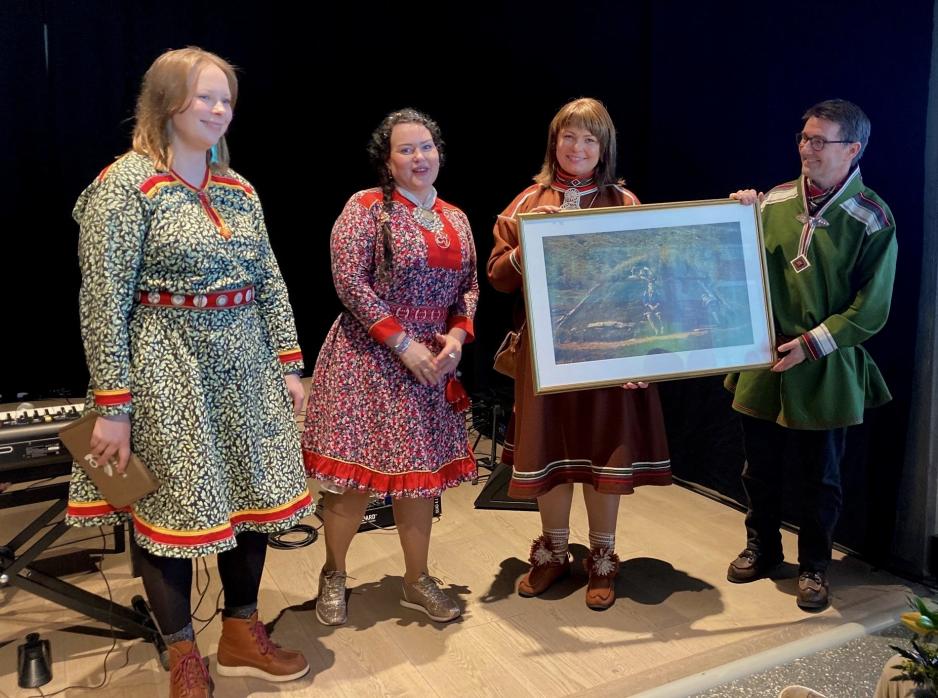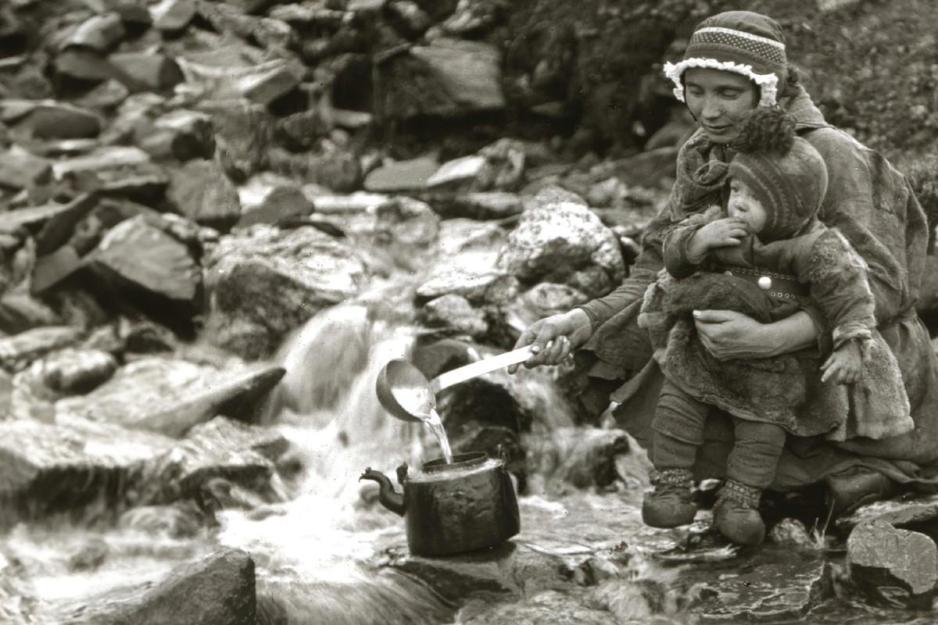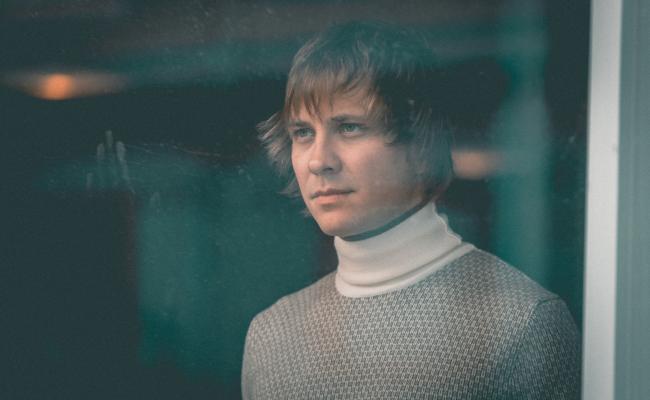Tromsø Sàmi House Opened: "A Sàmi Haven Where We Can Face Challenges Together"

Sámi Parliament President Silje Karine Muotka (second to the left) and Sandra Márjá West, political advisor for the parliament's Executive Council (far left), at the opening of Romssa Sámi Viessu/Sámi House in Tromsø. Here, they present a gift to the house, represented by manager Jill Abelsen Olsen and chair Torjer Olsen. The gift is a photo from the old Sámi summer residence in Romsavággi/Tromsdalen from around 1920. The photo has been adapted by Sámi artist Hans Ragnar Mathisen. (Photo: the Sámi Parliament)
The Sámi House in Tromsø, Northern Norway, has been inaugurated. To heal the damage of Norwegianization, it is crucial to have meeting places for Sámi people to develop their language, culture, and identity, says Silje Karine Muotka, President of the Sámi Parliament.
After an almost 30-year-long and motley process, the Sámi House (Sámi Viessu) in Tromsø (Romssa), Northern Norway, has finally opened its doors.
The house's premises were inaugurated last Saturday with speeches, yoik, and other cultural elements.
This new Sámi arena has been brought to life through a cooperation between Tromsø municipality, Tromsø county, and the Sámi Parliament (Sàmediggi), which was initiated in 2022.
"A house can only be a house, but this Sámi House will be a place to gather and a safe meeting place for Sámi language and culture. For those who are curious, those who want to learn, those who want to teach, and those who want to be together."
That comes from Tromsø Mayor Gunnar Wilhelmsen (Labour), the Chair of the County Government of Troms and Finnmark Kristina Torbergsen (Labour), and Sámi Parliament President Silje Karine Muotka (NSR) in a joint statement on the opening.

Representatives for the owners of the house: Tromsø Mayor Gunnar Wilhelmsen, the Sámi Parliament president Silje Karine Muotka and committee leader Eirik Losnegaard Mevik in Troms County Council. (Photo: Silje Solstad/Tromsø municipality)
Progress, but still a way to go
Tromsø has long been a settlement and hub for the Sámi people. Still, the legacy of the state's Norwegianization policy lingers, the Sámi Parliament president points out in her speech at the opening ceremony.
"Today, Tromsø is a kind of urban Sámi epicenter where you find the Sámi population who have always been here, and who want to get to know their Sámi history better, and a multitude of Sámi who have moved in from all over Sápmi," says Muotka.
The president points to a great interest in local events where you can see, listen to, and learn about Sámi art, history, language, and the traditional craft duodji. She also notes that more people wear Sámi clothing on the national days of February 6th and May 17th.
"At the same time, we must not forget that the Norwegianization damages still impact Tromsø. This is reflected in the fact that Sámi people still experience discrimination on the street and that many avoid wearing Sámi clothing to avoid comments and bullying."
"The Sámi people in Tromsø have many challenges, and what could be better than having a meeting place, a Sámi haven where we can face challenges together."
Central in the reconciliation work
Norway's Truth and Reconciliation Commission presented its report a year ago. This report forms the basis for approaching the state's policy of assimilation of the Sámi and other minorities in Norwegian society.
"The report leaves no doubt that the Norwegianization has left deep wounds and that a number of measures must be made to deal with the damage caused by it," says Muotka and continues:
"The Sámi Parliament believes that one of the most important measures is investing in Sámi meeting places. It cannot be emphasized enough how crucial it is to have meeting places where Sámi people of all ages can develop their language, their culture, and their identity. Romssa Sámi Viessu is such a place – that we all can use and feel at home in."
A look back
"Old maps and church books tell us that the Sámi population has stayed in and around Tromsø both as permanent residents and visitors. More people came with reindeer from the Swedish side of Sápmi until the border was mercilessly closed to the reindeer-herding Sámi people from 1919. This destroyed centuries-long residential patterns for many families, while at the same time, permanent resident Sámi were Norwegianized through a long process initiated and approved by the Norwegian state. The Sámi population became less visible in the cityscape – and the general population distanced themselves and became alienated from Tromsø's Sámi history. This has had a significant impact and has affected people here for a long time, says Muotka.
Well underway, with more to come
The company responsible for realizing the Sámi House in Tromsø was founded in 2023 and signed a contract to move into the Prosneset harbor terminal this winter.
Throughout the spring, the house has hosted several open events: art exhibitions and lectures by Sámi guides, duodji workshops for children, youths, and adults, a cafe with language games for children in Southern, Lule, and Northern Sámi, pizza nights with board games for youths, and reading days for students.
This is just the beginning, emphasizes the company's chairman, Torjer Olsen. He is a professor of indigenous studies and head of the Center for Sámi Studies at UiT – the Arctic University of Norway.
"The most important thing will occur in the coming time: It is people and what people do that create the meeting place. The goal is for this to be a safe and good place to come to, whether you are Sámi, if you are not entirely sure whether you are Sámi, or if you are just interested in Sámi topics," writes Olsen in the local newspaper iTromsø.
"We can look forward to Romssa Sámi Viessu as a vibrant center for cultural exchange and learning, where we can explore and preserve our traditions," underlines Eirik Losnegaard Mevik (Labour), head of the culture committee in Troms County Council, in his speech at the opening."
Shows Sámi traces in the Tromsø area
• Last week, the permanent exhibition Rávdnji – the Harsh Current opened at UiT - the Arctic University Museum of Norway in Tromsø.
• The exhibition highlights suppressed stories about Sámi history in the Tromsø area – with a focus on Rávdnjevággi/Kvaløya and Romssavággi/Tromsdalen.
• Collectively, it gives insight into the rich Sámi presence in the city and its surroundings over millennia.

Photo from Romssavággi/Tromsdalen. This suburban area in Tromsø is part of a larger story about the consequences of Norwegianization, forced relocation, and closing of borders between Norway, Sweden, and Finland for reindeer relocation. (Photo: Unknown photographer/UiT – the Arctic University Museum of Norway. Parts of the background have been filled in using AI)






